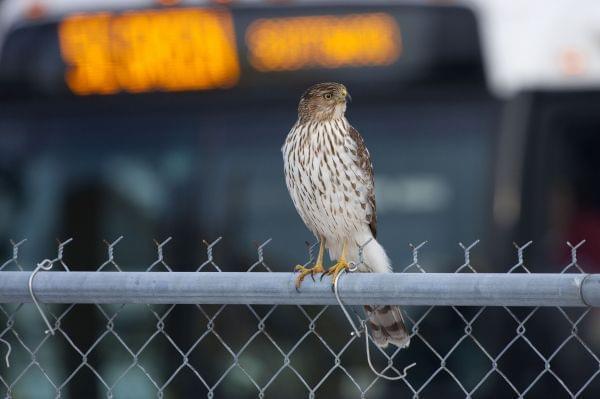Raptor watching in winter

A Cooper's hawk rests on a fence near the Illinois Terminal in downtown Champaign. Rob Kanter
Some years ago—never mind how long precisely--I took advantage of a break in the morning rain to bicycle from my home in Champaign to my office on campus at the University of Illinois. As I approached a vacant lot on White Street just east of First, five crows swooped in to land in a leafless silver maple tree, where another crow was already perched, calling as though his life depended on it. The others took up the cry with equal fury, rocking back and forth and bobbing their heads in the direction of a midlevel branch.
On that branch sat a red-tailed hawk, miserable from a night of rain, her wet feathers buffeted by the wind, and now under assault by six angry crows. The hawk was clearly agitated by all the attention, but she stayed put, and after a bit, the crows moved on.
Coincidentally, at the time I witnessed this scene I was on my way to the office to write about looking for birds of prey in late fall and winter. These seasons may be lousy for other outdoor activities, but they provide great opportunities to see hawks, falcons, owls, and even eagles—the meat-eating birds known collectively as raptors.
This incident also illustrates much of what I intended to say about looking for birds of prey.
First, it shows that paying attention to the behavior of other birds can help you to see raptors you wouldn’t otherwise notice. Any time you’re outdoors and you hear an excited group of crows or blue jays, take a minute to see what’s causing the stir. Crows and jays make it their business to track and harass birds of prey whenever they encounter them. Find the center of their attention, and you may well find a hawk or an owl.
The behavior of birds being hunted by hawks can also alert you to their presence. Cooper’s hawks, for example, often prey on birds that congregate at backyard feeders. So if you’ve got a yard full of sparrows that goes suddenly still, look up. There could be a hawk soaring overhead, or perched in a tree nearby. And if the small birds at your feeder all take flight together, look to see whether a cooper’s hawk has zoomed in to grab one.
My hawk sighting also illustrates the point that you need not make special trips to observe raptors, especially when the leaves are off the trees--you have a chance to see them anytime you step out the door, even in urban areas. Red tailed hawks, Cooper’s hawks, great horned owls, screech owls, and American kestrels all have adapted to life in built up human environments. In our area numbers of these birds are steady to increasing, thanks to the 1972 ban on DDT.
You can see even more birds of prey with a little bit of looking. Winter travel provides excellent hawk watching opportunities, since the grassy strips along highways are such good habitat for the small mammals that hawks and falcons often eat. Of course, if you’re driving, you want to keep your eyes on the road, but if you’re a passenger you can spot raptors by scanning the tops of fences, road signs, and power poles, where hunting birds might perch.
All of this is really to say you don’t have to turn on the Discovery channel to see birds of prey. They live among us, and this is a great time of year to look for them.
A note: Although I seldom write about environmental politics directly, I don’t see my work as apolitical. Valuing biodiversity, for example, means supporting policies that protect wildlife, as in the case of the 1972 ban on DDT mentioned in this week’s column. For readers who are looking to make sense of what the recent election means from an environmental perspective, I would suggest starting with the Andrew Revkin’s Dot Earth blog at the New York Times [http://dotearth.blogs.nytimes.com/]. Revkin maintains contacts with a diverse set of well-placed sources, and he helps readers make sense of mountains of writing by others on science and the environment.

